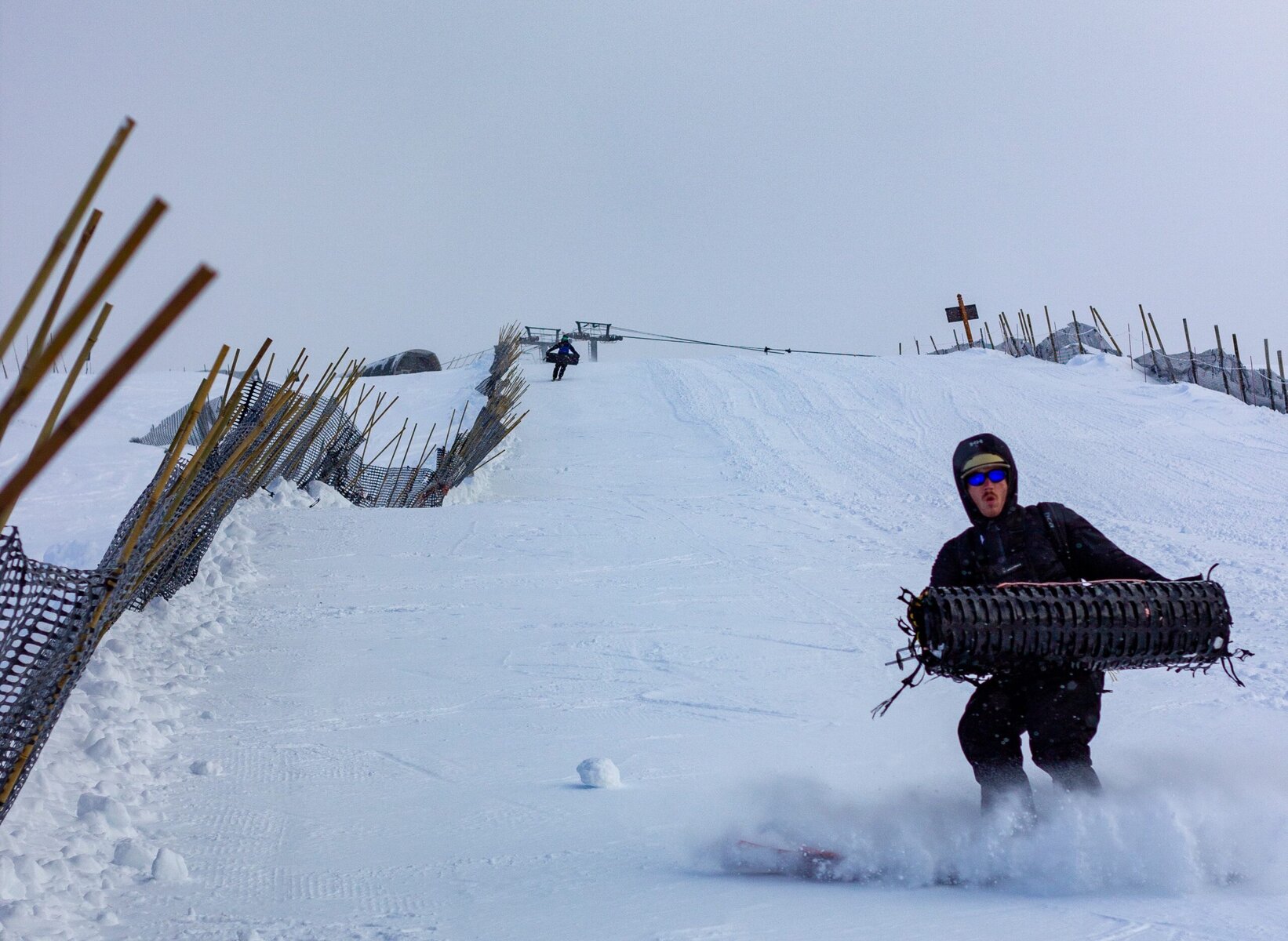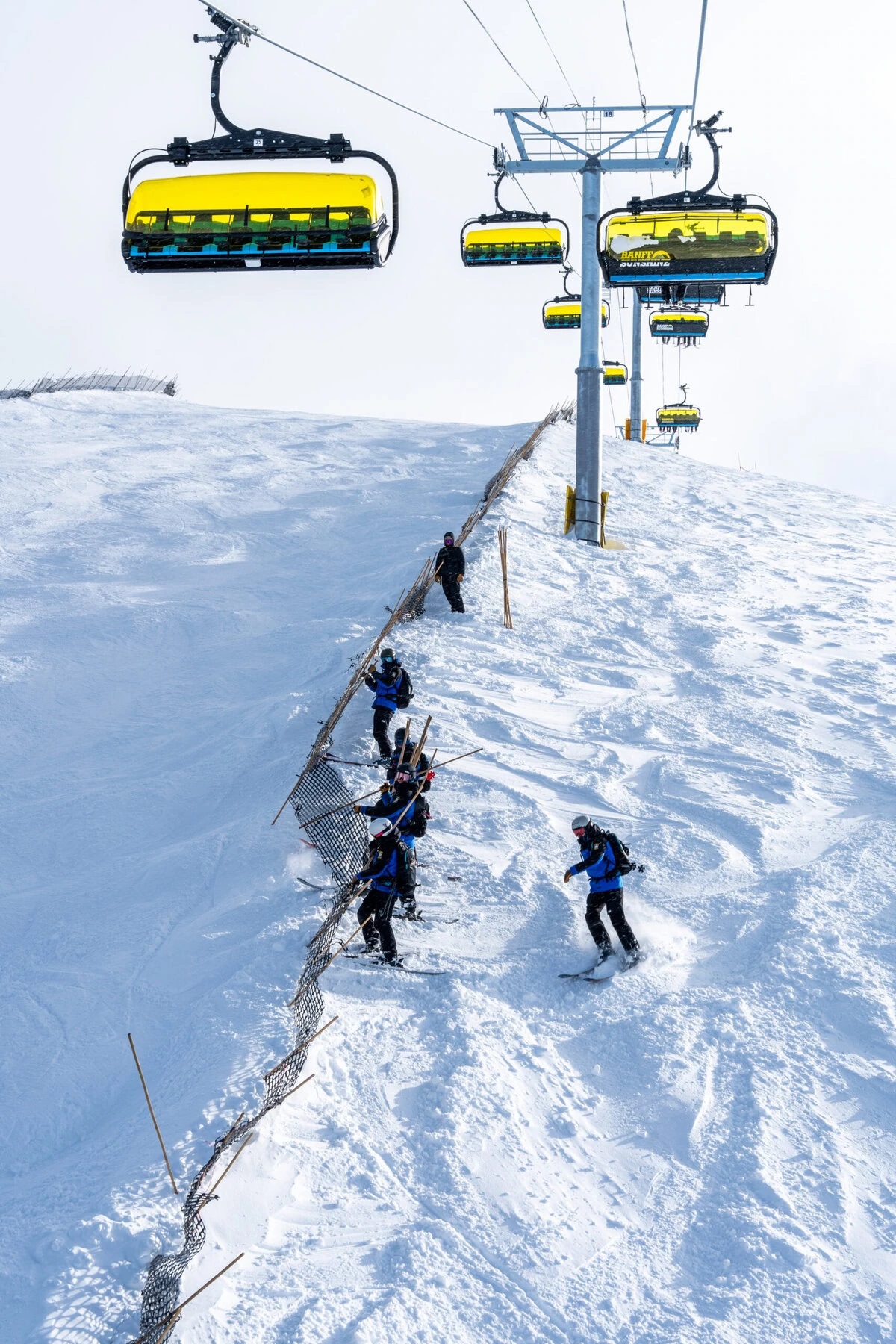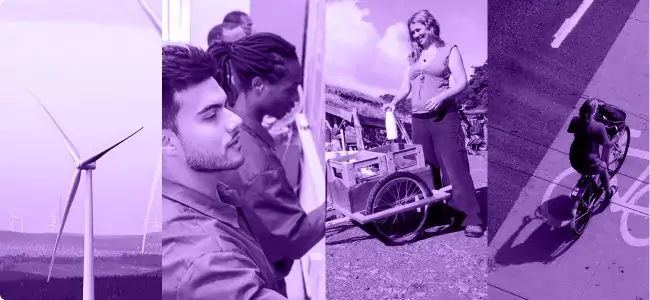At its zenith, Monarch Mountain in south-central Colorado is over 11,000 feet tall. Skiing here is being on top of the world. Each winter, snow generously blankets the slopes, providing the fresh powder for which Colorado is known. The resort’s height and position on the Continental Divide traps moist air over the mountains, where it cools quickly, and snow can fall readily by late September some years.
“We have never had a traditional snowmaking system up here,” says Malcolm Wilber, assistant director of base operations. Instead, since the resort opened in the late 1930s, the runs have been groomed and the snow depth has been augmented with snow harvested primarily from the resort’s parking lots. To trap more snow, holes are dug and deep ruts are forged in the existing snowpack. Monarch Mountain is, however, an exception. Manmade snow cover on skiable terrain in the U.S. ranges from 62 percent in the Northeast to 98 percent in the Midwest.

When it comes to the need for artificial snow, “I think it’s all about the difference between what you’re trying to create as a product and also what your constraints are,” says Wilber. “If some of these ski areas have a base elevation in that 6,000- to 8,000-foot range they’re going to need to blow snow to get their areas set up because they just don’t have those early season snowstorms.”
Artificial snow is made by forcing water droplets into the air through a snow cannon or lance at high speed. The water quickly cools, freezes and forms snowflakes that fall to the ground. Natural snow, which falls from great heights, traps air between ice crystals to create the quintessential fluffy snowflake. In contrast, artificial snow forms closer to the ground and is therefore denser. This makes it able to withstand warmer air temperatures, allowing ski hills to remain open well into spring. Side-stepping Mother Nature, though, can have consequences.

As climate change affects snowpack at ski areas around the world, questions have arisen about the sustainability of snowmaking. According to SMI Snow Makers, a global supplier of snow-making equipment, an area 200 feet by 200 feet covered with six inches of artificial snow requires almost 75,000 gallons of water.
In 2023, researchers at Canada’s University of Waterloo and Austria’s University of Innsbruck published a study on the impact of making artificial snow, using Canada as an example. They found that the power and infrastructure needed to run the snow cannons and to pump the water required to cover Canada’s ski hills with 42 million cubic meters of human-made snow annually results in 130,095 tons of associated CO2 emissions per year. A growing number of ski resorts are turning to green energy for power, such as Grouse Mountain in Vancouver, where a wind turbine offsets up to two percent of the mountain’s annual power consumption, but it’s a drop in the bucket.
Weighed down by negative news?
Our smart, bright, weekly newsletter is the uplift you’ve been looking for.Beyond energy consumption, there are other environmental concerns. Because artificial snow melts at a slower rate than natural snow, it inhibits early spring plant growth, trapping seeds and sprouting plants longer under a snow layer. This leaves wildlife unable to access the food they rely on to survive. And then there’s the noise. At 60 to 80 decibels, the sound snow making equipment produces is the equivalent of the constant drone of heavy traffic. Noise pollution can have serious impacts on wildlife, causing animals to avoid areas and not forage as they need for survival. It’s something Wilber worries about. “We start to get those first snows, and our elk and coyote herds are starting to make it down into the valley to find food, but you’ve got snow guns going all night long down there,” he says.

At Banff Sunshine Village in Alberta, “snow farming,” says Kendra Scurfield, vice president of marketing brand and communications, “is a great way to catch what you get from Mother Nature and spread it around.” Spanning 3,300 acres across three mountains, the area’s ski terrain relies solely on farmed snow. “We don’t have a water source near us, so we’ve had to rely on snow farming to get our terrain open,” she says.
Snow fences go up at Banff Sunshine with the first snowfall in mid-October. The length of the fence doesn’t matter as much as the height — usually about five feet. The fence serves as a barrier to prevent the snow from blowing across the mountain. Once enough snow has amassed, the fence is removed and the snow is spread out evenly to create wide swaths of open skiing terrain.

But to farm snow, of course, you need snow, and as climate change continues to accelerate and the planet warms, snow is endangered. Data suggests that a lack of snow could shorten ski seasons by upwards of 62 days by 2050. Even at 7,200 feet above sea level, Banff Sunshine is already feeling the impact. “We are seeing our snowfall in cycles,” Scurfield says. “We will have good years, such as 2021 to 2022, one of our snowiest seasons ever, and then we’ll have lower-than-average years.”
At Mt. Baker Ski Area in Washington State, General Manager Mike Trowbridge believes a little insurance goes a long way in making sure the snow farmed from the mountain’s parking lots and high alpine lasts. “Before the season starts we create wood chips on site,” explains Trowbridge. “We then spread them out maybe four to eight inches deep on the high traffic areas. The snow lasts a lot longer when we’ve got a layer of wood chips down as opposed to if we were to let it sit right onto the gravel or the rocks or whatever the bottom surface is.” The wood chips act as insulation, separating the snow from the warmer ground and preventing melt.
Trowbridge doesn’t rule out more extreme farming methods. “As conditions on the ground change, we are remaining flexible,” he says. He’s very interested in snow farming methods used in places such as Switzerland. There, ski areas collect natural or artificially made snow from previous winters, cover it with wood chips, specially designed insulated mats or sawdust and store it, over the summer, in shaded areas for use the following ski season.
This method is not widespread in North America, but it has grabbed the interest of a few places, including the Craftsbury Outdoor Center in Vermont. Co-owner Judy Greer tells CBC News that they started with small piles of harvested snow and discovered that with a thick layer of wood chips, they could keep 65 to 70 percent of what they’d harvested throughout the summer. This gave them confidence to scale up to a pile of snow covering nearly 212,000 cubic feet.
Back at Monarch Mountain, while Wilber admits that not every year is a great snow year, the mountain is going to ride out the changes in climate for as long as possible and continue to farm snow. “Our snow quality is just a lot better than other places. Our trails just hold up so much better and so much longer. They don’t turn icy. We’ve been snow-farming for 85 years,” he says with a laugh. “We’re starting to get good at it.”





